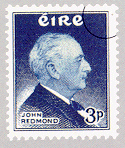
 John Redmond-: (1856-1918), Irish nationalist leader,was born in Waterford in
1856. Elected (1881) to the British Parliament as a HOME RULE member, he led the faction
supporting Charles Stewart PARNELL and became chairman of the unified Irish party in 1900.
Having supported the third Home Rule bill, he was stunned by the Easter Rebellion of 1916.
His influence later declined, and he was opposed by the revolutionary SINN FéIN. At the
beginning of the Great War in 1914, Ireland was part of the United Kingdom governed from
Westminster.Ireland was represented in the Parliament by 105 MP's, one third of whom were
Unionists and generally supported the Conservative Party. The majority of Irish MP's were
members of the Home Rule party which had been campaigning for nearly forty years for the
right to have their own Parliament in Dublin to take care of domestic affairs but still
maintain the link with Britain. The leader of this party in 1914 was John Redmond and when
war broke out in August of that year he was to be influential in urging Irishmen to
support the British war effort.
John Redmond-: (1856-1918), Irish nationalist leader,was born in Waterford in
1856. Elected (1881) to the British Parliament as a HOME RULE member, he led the faction
supporting Charles Stewart PARNELL and became chairman of the unified Irish party in 1900.
Having supported the third Home Rule bill, he was stunned by the Easter Rebellion of 1916.
His influence later declined, and he was opposed by the revolutionary SINN FéIN. At the
beginning of the Great War in 1914, Ireland was part of the United Kingdom governed from
Westminster.Ireland was represented in the Parliament by 105 MP's, one third of whom were
Unionists and generally supported the Conservative Party. The majority of Irish MP's were
members of the Home Rule party which had been campaigning for nearly forty years for the
right to have their own Parliament in Dublin to take care of domestic affairs but still
maintain the link with Britain. The leader of this party in 1914 was John Redmond and when
war broke out in August of that year he was to be influential in urging Irishmen to
support the British war effort.John Redmond had been leader of the Home Rule party since 1900. At that time the Party recognised that the biggest obstacles to Home Rule came from the House of Lords, the Conservative party and the Unionist Party itself. The second Home Rule Bill had been passed in the Commons in 1893 but rejected by the Lords. However, the rejection of Lloyd George's "People's Budget" by the Lords in 1910 was to be of great significance to the Home Rule Party. A General Election was called which resulted in a victory for the liberals but they were dependent upon the support of Redmond and his party. Then came the Parliament Act of 1911 which meant that the Lords could delay the passage of Home Rule but could not veto it.
The Third Home Rule Bill was introduced in April 1912 and this was to mark a high point in the political career of John Redmond. Home Rule was now only a matter of time. However, Unionists in Ireland mounted strong opposition to the Bill. In September 1912 the Ulster Covenant was signed by 471,414 men and women who pledged to use "all means that may be necessary to defeat the present conspiracy to set up a Home Rule parliament in Ireland". In 1913 the Ulster Volunteer Army was set up to defy the government by force of arms if necessary. In 1914 the UVF successfully brought in a large consignment of guns and ammunition from Germany.1913 also witnessed the formation of yet another private army in Ireland, namely the Irish Volunteers. They were under the leadership of the Nationalist, Eoin MacNeill and were totally committed to the cause of securing Home Rule for Ireland.
As 1914 began, Ireland seemed to be moving closer and closer to a civil war between the
Ulster Volunteers and the Irish Volunteers. By the summer of that year the Third Home Rule
bill was indeed on the Statute Book but with the outbreak of war, it's operation was
suspended until after the war.
In August 1914, thousands of Ulster Volunteers flocked to join the British army in order
to demonstrate their complete loyalty to Britain and in this way succeed in having Home
Rule abandoned completely. In order to ensure that Home Rule would be granted, John
Redmond believed that members of the Irish Volunteers should also join the British army
and in a speech in Co. Wicklow in September 1914 he pledged his support for the Allied
cause and urged the Irish Volunteers to "account yourselves as men not only in
Ireland but wherever the firing line extends in defence of right, of freedom and religion
in this war." The majority of Volunteers heeded the call and by October 1915 there
were over 100,000 Irishmen fighting on the side of Britain in the Great War.